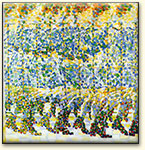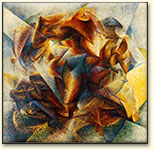Futurists' Forms of Dynamic Movement
Futurism was a short-lived Italian art movement, launched in 1909, that included artists such as F. T. Marinetti (1876-1944), Giacomo Balla (1871-1958), Carlo Carra (1881-1966), Umberto Boccioni (1882-1916), Luigi Russolo (1885-1947) and Gino Severini (1883-1966). Compare and contrast Boccioni’s and Balla’s lively works to Nicolas Poussin’s static representation of moving figures in Rape of the Sabine Women (1634). Why are the futurists so successful in their depiction of movement?
Boccioni’s Dynamism of a Soccer Player (1913) approaches abstraction in its depiction of motion. Like the Cubists, Boccioni’s pictorial language is based on shallow spaces and shifting planes. However, more than any other artists in the modern period, Boccioni and the futurists focus on depicting optical and temporal space, which reflects the dynamic speed and noise of the modern age. Thus, instead of representing a fixed moment, the work depicts a dynamic sensation. Boccioni, in Technical Manifesto of Futurist Sculpture (1913), discusses futurist art as a representation of dynamic forms that propel themselves to the surrounding atmosphere. According to Boccioni, “The figure must be broken open and enclosed in environment”. Therefore, Dynamism of a Soccer Player is not only a painting of a soccer player, but also a representation of the player’s energy, spreading around his surrounding atmosphere. In doing so, the work breaks down the distinction between the body and the body in motion.
Like Boccioni’s painting, Balla’s Girl Running on a Balcony (1912, above) is a kinesthetic study of a figure in motion. Borrowing from the pointillist technique, Balla has not mixed his non-primary colors in advance, but creates those by painting contrasting dots in close proximity to one another. Without emphasizing any element in the work, this technique is repeated throughout the picture surface. Therefore, the work does not have a central point of focus. In contrast, it appears to be continuing outside the canvas to the spectator’s space, emphasizing the continuous and instable character of the girl’s motion. Although Boccioni’s Dynamism of a Soccer Player is more abstract than Balla’s Girl Running on a Balcony, we can make sense of both works as they recall our peripheral vision. They appear, lively and dynamic, as if they represent a passing moment in time, captured by our peripheral vision.

